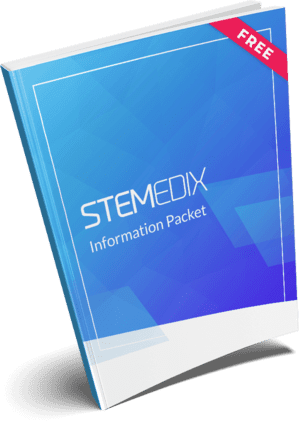
by Stemedix | Sep 6, 2021 | Stem Cell Therapy
Stem cell therapy is an exciting treatment option for patients who are facing a variety of health challenges. It is particularly beneficial for patients who are struggling with orthopedic and sports-related injuries. Like any athlete, these patients are all too eager to get back to their normal activities. However, they must adhere to post-management care protocols to maximize the benefits of stem cell therapy.
Whether you are thinking about undergoing stem cell treatment or you’ve just completed your procedure, we want to help by providing some post-management suggestions on how best to ease back into the activities that you love. Always discuss with your provider to ensure the post-treatment protocol is best for your specific case and healing process.
Weeks One and Two
During the first two weeks after your procedure, limit your activities to basic tasks that are necessary for daily life. You may experience soreness, but general movement like light walking will help to speed up your recovery process.
If your treatment was focused on the hip or knee joint, then we recommend avoiding stairs, uneven ground, or deep squats. You should also avoid weightlifting or any strenuous activity during this stage of the recovery process.
Apply heat only for the first two weeks. In the morning, apply heat, massage, and stretch. Repeat in the evening. If possible, use a massage assistance device.
Weeks Three and Four
During weeks three and four, you should still avoid weightlifting, running, and repetitive load-bearing exercises. However, incorporating an elliptical or exercise bike into your routine is a great idea. You can also go for a swim during this period, as any incisions should be sufficiently healed.
As a general rule, let pain be your guide. If a particular movement hurts, stop or slow down. Continue to avoid NSAIDs until after week four. If you are experiencing inflammation, you can now alternate between hot and cold compresses.
Weeks Five Through Eight
During weeks five and six, you may transition into some light weightlifting, but avoid anything that compresses the joint. For instance, if you received stem cell injections in the knee, then you should avoid deadlifts, squats, box jumps, etc.
Once you have made it to week seven, begin easing back into your regular training regimen. Increase weights slowly and avoid overloading the affected joint. Doing so could hinder the healing process and diminish the benefits of stem cell therapy.
Post-Treatment Benefits
When you’re receiving stem cell treatment for orthopedic conditions, it is common to experience benefits between the three- to six-month post-treatment time frame. Continue to build back up to your normal training volume and intensity. Follow the provider’s recommendations for optimal outcomes and be patient to allow the stem cells to facilitate their healing capabilities to the injured joint and tissues. Contact us today to learn more about post-management care.

by admin | Sep 3, 2021 | Stem Cell Therapy, Mesenchymal Stem Cells, Stem Cell Research
Human mesenchymal stem cells (hMSCs) are multipotent adult stem cells found in tissue throughout the body, including in the umbilical cord, bone marrow, and adipose tissue. Capable of self-renewing and differentiating into multiple tissues including bone, cartilage, muscle, fat cells, and connective tissue[1], MSCs appear to have a wide range of potential for use as therapeutic purposes for many serious health problems occurring throughout the body.
In this review, Rodriguez-Fuentes et al. examined currently registered (as of July 2020) clinical trials involving mesenchymal stem cells with the goal of analyzing the different applications of MSCs in a clinical setting to demonstrate the growing and broad potential of their therapeutic application relative to the reconstruction of damaged tissue.
As of July 2020, the authors identified 1,138 registered clinical trials (CTs) worldwide using MSCs to investigate their therapeutic potential. Therapeutic applications are a relatively new area of study, evidenced by the fact that only 19 CT studies were started between 1995 and 2005 and over 900 were initiated in the last ten years (2011-present). The majority of these CTs focused on the fields of traumatology, neurology, cardiology, and immunology. Interestingly, of the 1,138 CTs identified in this query, only 18 had published outcomes.
Examining the global distribution of registered CTs, it was observed that CTs are located in 51 countries, with China (228) and the US (186) leading the research.
As part of this review, and in addition to examining the number and geographic locations of registered CTs, the sourcing, isolation and treatment methods, and storage conditions of MSCs used in each clinical trial.
Most of the MSCs used for these CTs were obtained from cells of the iliac crest, placenta, and adipose tissue. All recovered cells underwent steps of purification and expansion prior to use in patients. Additionally, all methods used in these CTs were also found to follow good manufacturing practices (GMP).
Upon completing their review of registered CTs, Rodriguez-Fuentes et al. also observed that medical specialties for the most published studies included (in descending order) cardiology, traumatology, pneumology, neurology, hematology, ophthalmology, and plastic surgery. The most frequent pathologies addressed in these published CT studies included knee osteoarthritis, ischemic heart disease, and dilated cardiomyopathy. While the number of MSCs used varied by study, most utilized around 100 million MSCs.
The authors concluded that most studies analyzed as part of this review demonstrate positive outcomes with no serious adverse effects. While China and the US lead the world in the number of registered MSC clinical trials, the authors point out the fact that many of these CTs have multiple locations in different countries – indicating the importance of, and willingness to, collaborate internationally on this research.
Although most of the conditions for which clinical utility of MSCs have been published are conditions that do not currently have specific treatments with desirable or effective outcomes, there appears to be significant and broad potential for the clinical use of hMSCs without serious adverse events.
While there are currently at least 1,138 registered MSC CTs, there is still much to be examined and understood about MSCs. As such the continually increasing number of CTs including MSCs will help identify and demonstrate the therapeutic potential of these versatile stem cells.
[1] “Mesenchymal stem cells – Latest research and news | Nature.” https://www.nature.com/subjects/mesenchymal-stem-cells.
Source: Mesenchymal Stem Cells Current Clinical Applications. From https://www.sciencedirect.com/science/article/pii/S018844092030638X

by Stemedix | Aug 30, 2021 | Osteoarthritis, Stem Cell Therapy
Before the advent of stem cell therapy, patients that were suffering from osteoarthritis were forced to rely on traditional treatment options. These treatments included oral medications, cortisone injections, and surgical intervention. Fortunately, stem cells have shown to be a promising and safe alternative treatment option. Stem cell therapy has the potential to help patients improve their quality of life, reduce pain, and potentially halt the progression of osteoarthritis. Below are the stem cell therapy benefits for Osteoarthritis. They are outlined so you can make an informed decision regarding the best options to manage your osteoarthritis.
What Are Stem Cells?
Stem cells are a unique type of cell that is often described as the body’s raw building blocks because they are used to form a variety of other specialized cells. Stem cells can be harvested in a laboratory setting and concentrated for various therapies. They can be used to treat neurodegenerative, autoimmune, and orthopedic ailments.
Two primary types of stem cells that are used more commonly today in medical therapies are known as adult autologous stem cells and umbilical cord-derived stem cells.
Autologous stem cells are derived from harvested adipose (fat) tissue or bone marrow aspirate. Umbilical cord-derived stem cells are retrieved from Wharton’s Jelly, which is a substance that lines the interior of umbilical cords.
How Can Stem Cells Improve Osteoarthritis Symptoms?
While stem cell therapy is still being refined and improved upon, it has shown positive results in clinical trials. In many of these studies, stem cells proved to be a potentially effective therapy for osteoarthritic conditions to offer patients additional options to consider in addition to several traditional options. Below are some improvements reported.
Reduce Pain and Inflammation
Although it is technically not a cure nor can be guaranteed, stem cell therapy has been shown to help relieve some of the most debilitating symptoms that osteoarthritis patients encounter like pain and inflammation.
Chronic pain and inflammation have the potential to diminish a person’s quality of life. These ailments can prevent a person from participating in activities they enjoy and reduce their mobility. Many patients have experienced drastic pain improvement after using stem cell therapy. Some of them saw improvements as soon as one month following their treatment. Post-treatment care is also important for patients to follow to help optimize their outcomes.
Improved Functionality
As pain and inflammation subside, functionality tends to improve. Stem cell therapy has helped a high percentage of patients to become more independent and resume normal activities. They were able to become less reliant on others and saw improvements in functionality when compared to other treatment options.
Halts Progression of Osteoarthritis
In some trials, stem cell therapy was able to halt the progression of osteoarthritis. While these results were not typical, it does bode well for patients that are struggling with severe osteoarthritic conditions.
If you are suffering from osteoarthritis or other orthopedic conditions, you may want to explore the stem cell therapy benefits for Osteoarthritis. This treatment option might help you improve your quality of life and achieve better outcomes in addition to your current standard of care options. If you would like to learn more about getting started contact us today!

by Stemedix | Aug 23, 2021 | Stem Cell Therapy
Stem cells are a groundbreaking form of regenerative medicine that is being used to potentially help manage many ailments, including orthopedic injuries and chronic conditions. This treatment option offers many potential benefits to patients that suffer from orthopedic conditions. Here we will talk about the Orthopedic benefits of Stem Cell Therapy.
While stem cell therapy is not necessarily a cure for these ailments, patients have reported improvements in their symptoms without the need for more invasive treatments such as surgery.
What is Stem Cell Therapy?
Stem cells are unique because they have the ability to divide and transform into specialized cells. Stem cells can facilitate the body’s natural healing processes and repair damaged tissue. However, the concentration of stem cells in your body naturally decreases as you age.
Mesenchymal stem cells can be harvested stem cells from one of several sources. Stem cells can be harvested from bone marrow aspirate, adipose (fat) tissue, or umbilical cords (Wharton’s Jelly). Once harvested, the stem cells are administered directly to the problematic areas and/or systemically with an IV.
Stem cell therapy targets your orthopedic ailment with a high concentration of these cells. These cells will divide and replace damaged tissue, thereby alleviating or improving your chronic orthopedic symptoms.
How Are Stem Cells Used to Treat Orthopedic Conditions?
Orthopedic conditions are usually the result of inflammation and damage to bone, ligaments, tendons, or cartilage. Stem cells are naturally drawn towards inflammation within your body. In addition, stem cells can differentiate into various cells, including progenitor cells. Once this occurs, they can transform into specialized cells, such as those in your musculoskeletal tissues.
Instead of managing orthopedic conditions with medication or surgical intervention, stem cells can offer an alternative option for patients to explore. These cells have the potential to provide the body the resources it needs to rebuild damaged tissues naturally.
Potential Benefits of Stem Cells
Stem cell therapy is continuing to be researched but studies have shown it to be a safe and potentially effective treatment option for many patients that are struggling with orthopedic conditions. While your physician cannot guarantee that your stem cell therapy will produce a specific outcome, this treatment option does offer many potential benefits.
Stem cell therapy uses natural materials and your body’s innate healing abilities to treat orthopedic conditions. This allows you the opportunity to manage your condition without the use of medications and surgical interventions. Many medications can have some side effects. Stem cells have been shown to have minimal side effects and are safe to be considered a natural option.
If you are struggling with chronic pain due to an orthopedic condition or injury, stem cell therapy may be a considered treatment option to potentially help manage symptoms and improve your daily quality of life. If you would like to learn more about the Orthopedic benefits of stem cell therapy contact a care coordinator today!
Don’t let pain control your life, call us at (800) 531-0831

by Stemedix | Aug 16, 2021 | Degenerative Disc Disease, Stem Cell Therapy
Degenerative disc disease is one of the leading causes of neck and low back pain in adults. This medical condition results in many symptoms. It is caused by wear and tear on the spinal discs. In this article, we are going to talk about Stem Cell treatment of Degenerative Disc Disease.
Aside from back and neck aches, degenerative disc disease can result in:
- Numbness
- Hot or shooting pains
- Weakness
- A “giving out” sensation
- Muscle spasms and tension
- And more
The most common symptom of this condition is constant and low-level pain. Chronic pain can make it difficult to live a normal life. Because of the discomfort that comes from degenerative disc disease, researchers are looking for innovative treatments to help patients live more comfortably.
Recent Phase III Trial Results for Stem Cell Therapies
A recent randomized Phase III trial has shown that stem cell injections can help patients with degenerative disc disease. According to the study, a single injection provided long-term relief of back pain. The study was conducted using stem cell products from Mesoblast Limited, an Australian regenerative medicine provider.
Representatives from the company hope to meet with the Food and Drug Administration (FDA) to speed up the approval of their product. The product in question is known as “remestemcel-L.” The company has been developing this stem cell product for several years.
Like many stem cell treatments, the product is made using bone marrow to harvest mesenchymal stem cells. Those cells are then injected into patients’ bodies to reduce inflammation. The product inhibits the development of certain inflammatory substances. Decreased inflammation reduces the patient’s pain.
According to the trial report, sixty percent of the injected patients reported little to no pain after a year. After two years, 54% reported minimal or no discomfort. The injections provided the most pain relief for patients who were in the early stages of the disease.
Reduced Use of Opioids
Studies like the one discussed above have given many patients and medical professionals confidence in the potential of stem cells. In the study by Mesoblast Limited, more than 400 volunteers participated. Many of the patients who experienced pain relief decreased their use of opioids. Across the study group, opioid use declined by 40%.
Patients in the control group who received a saline injection actually increased their use of opioids. Because of this, the company hopes that the FDA will fast-track the approval of remestemcel-L as a standard treatment for degenerative disc disease.
Future studies will be necessary to determine the full potential of stem cell therapies. Still, many patients have experienced significant improvements in their health and wellbeing by using stem cell therapies. If you are interested in using stem cell treatment for Degenerative Disc Disease contact a care coordinator today to learn more!

by Stemedix | Aug 9, 2021 | Multiple Sclerosis, Stem Cell Therapy
In the United States, nearly one million people suffer from multiple sclerosis (MS). That is nearly one in 330 people nationwide. While the condition is not exceedingly common, it also cannot be classified as rare. The current number of people who have MS has doubled which is why more researchers have been delving into ways to treat the condition. For MS, the mean age of patients at the time of diagnosis is 34 years. The vast majority of patients are diagnosed between the ages of 20 and 50. However, MS has also been known to affect children and teenagers. In this article, we are going to talk about the stem cell transplant benefits for patients with MS.
The Slowing of Progression
Much of the research and medical development for MS have been focused on slowing the progression of the disease. There are currently several medications on the market that are geared toward doing just that. There has also been stem cell research done that has shown positive results.
While many drugs have succeeded in slowing the progression rate of MS, one important downside is the cost. Long-term use of these medications can affect a patient’s budget. If remission is gained, however, the patient can discontinue those drugs indefinitely.
One experiment involved patients from four countries, including the United States. All of the patients were given chemotherapy. Following this treatment, half were given drugs and the other half were administered stem cell therapy.
All patients that received the stem cell injections were clear from recurring symptoms after a year. Only six out of 52 had recurring symptoms after three years. The results of this experiment were released just a few years ago and have garnered the attention of researchers, as well as the desire for more trials.
Older Research
Stem cell therapy for the treatment of MS has been around for longer than most people realize. It began in the 1990s with hematopoietic stem cells, or HSC transplants, for patients that were not responding well to the conventional medications given at the time.
The method used for some of these trials was immunoablation. This is the process of partially destroying a faulty immune system and then replacing it with newer, healthier cells. Researchers have used it in further studies based on its early encouraging results. With this in mind, there may be hope on the horizon for the use of stem cells to achieve remission. If you are interested in scheduling a consultation contact a care coordinator today!







 St. Petersburg, Florida
St. Petersburg, Florida
